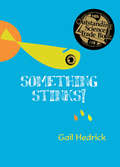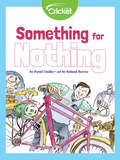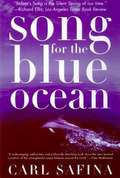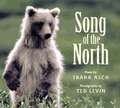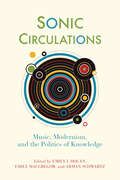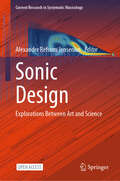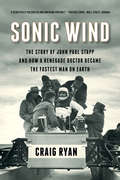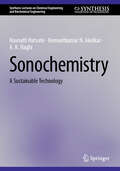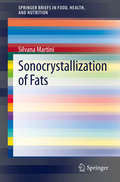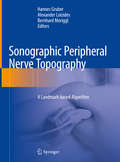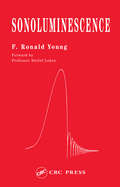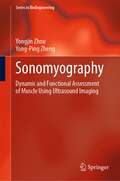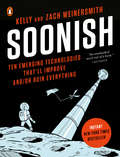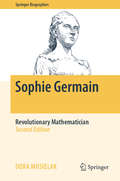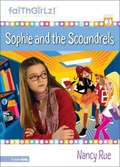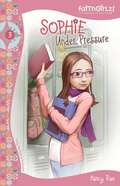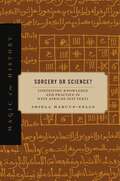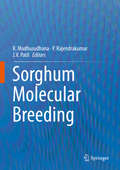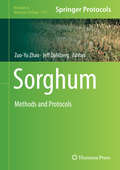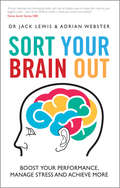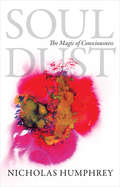- Table View
- List View
Something Stinks!
by Gail HedrickDead fish are washing ashore on the Higdon River, and seventh grader Emily Sanders decides to find out why. Mocked by her fellow students and abandoned by her best friend, Emily investigates farms, a golf course, and local factories. Gradually she persuades friends to help her test the waters. Their investigations lead them into trouble with the law and confrontation with the town's most powerful citizen. Can a handful of determined seventh graders find out the true source of the stink in the Higdon River?
Something for Nothing
by David LindleyFollow along this brief history of the pursuit of perpetual motion machines and how this endeavor led to the laws of physics we have today. From Robert Park's generator-rigged bicycle, to Robert Fludd's self-running bicycle, to the steam engines of the 19th century, these stories offer a peek into some of mankind's successes and failures when it comes to the exploration of science and advancement.
Song for the Blue Ocean: Encounters Along the World's Coasts and Beneath the Seas
by Carl SafinaPart odyssey, part pilgrimage, this epic personal narrative follows the author's exploration of coasts, islands, reefs, and the sea's abyssal depths. Scientist and fisherman Carl Safina takes readers on a global journey of discovery, probing for truth about the world's changing seas, deftly weaving adventure, science, and political analysis.
Song of the North
by Frank Asch Ted LevinBear, Puffin, Moose, and all the other inhabitants of the North know its songs. It sings of clean icy waters for fishing, craggy cliffs for nesting, and smooth ponds for teaching babies to swim. The North embraces a community of creatures living together and sharing its resources.
Sonic Circulations: Music, Modernism, and the Politics of Knowledge (Sound in History)
by Edited by Emily I. Dolan, Emily MacGregor, and Arman SchwartzThe role music, sound, and voice played in modern knowledge production in the early twentieth centuryDerived from the Latin words circum (round) and ire (to go), a circuit can refer to any bounded area. For contemporary readers, it might evoke the course of an electric current, as well as the flow of global capital. Yet sound—an inherently temporal phenomenon—can only circulate in mediated forms. Tracing the pathways through and by which sound traveled in the early twentieth century, Sonic Circulations not only proposes a new account of the role of music, sound, and voice in modern knowledge production but also poses urgent questions about technology and empire, while also foregrounding the tensions and paradoxes involved in situating the sonic within any fixed regime or system.Exploring key moments in the development of disciplines including linguistics, sociology, and eugenics, as well as musicology itself, Sonic Circulations explores the many ways that sound has functioned as evidence and information, as both an object and an agent of scientific mastery. Contributors explore the processes by which sound has moved through a variety of conceptual, as well as physical domains, highlighting the richness of historical contingency. This volume shows that circulation happened in many spaces and through many technologies: through sound recording, but also through the trade magazine and in the classroom; through wireless broadcasting and international festivals, but also in the cozy spaces of the suburban home.Featuring scholars working at the borders of musicology, ethnomusicology, sound studies, and music theory, this volume’s ten chapters and two epilogues illuminate an alternative genealogy of modernism, emphasizing the embeddedness of even the most abstract practices in the structures of imperial modernity.Contributors: Peter Asimov, Andrea F. Bohlman, Harriet Boyd-Bennett, Alexander W. Cowan, Emily I. Dolan, John Gabriel, Jonathan Hicks, Alexandra Kieffer, Gundula Kreuzer, Deirdre Loughridge, Emily MacGregor, Giles Masters, Arman Schwartz, Danielle Simon, John Tresch.
Sonic Design: Explorations Between Art and Science (Current Research in Systematic Musicology #12)
by Alexander Refsum JenseniusThis open access book offers a historical context and an overview of the field's current artistic and scientific research. Sonic design includes the construction and performance of acoustic instruments but also recording, editing, mixing, and synthesizing sounds using analog and digital electronic devices. This book explores sonic design from the perspectives of music theory, music perception, embodied cognition, phenomenology, soundscape studies, acoustics, new interfaces for musical expression, sound and music computing, and music information retrieval. The chapters are selected contributions from an international seminar organized to celebrate the achievements of Professor Rolf Inge Godøy at the University of Oslo. As a composer, researcher, teacher, and supervisor, Professor Godøy has been central in developing a holistic approach to sonic design, from theory to practice. This book offers a comprehensive overview of the field's current state, making it essential reading for students, practitioners, and researchers across a wide range of disciplines.
Sonic Wind: The Story of John Paul Stapp and How a Renegade Doctor Became the Fastest Man on Earth
by Craig RyanThe untold story of an eccentric, scientific visionary whose death-defying research has saved millions of lives. Sixty years ago, cars and airplanes were still deathtraps waiting to happen. Today, both are safer than ever, thanks in part to one pioneering air force doctor's research on seatbelts and ejection seats. The exploits of John Paul Stapp (1910-1999) come to thrilling life in this biography of a Renaissance man who was once blasted--faster than a .45 caliber bullet--across the desert in his Sonic Wind rocket sled, only to be slammed to a stop in barely a second. The experiment put him on the cover of Time magazine and allowed his swashbuckling team to gather the data needed to revolutionize automobile and aircraft design. But Stapp didn't stop there. From the legendary high-altitude balloon tests that ensued to the ferocious battles for car safety legislation, Craig Ryan's book is as much a history of America's transition into the Jet Age as it is a biography of the man who got us there safely.
Sonochemistry: A Sustainable Technology (Synthesis Lectures on Chemical Engineering and Biochemical Engineering)
by A. K. Haghi Navnath Hatvate Hemantkumar N. AkolkarThe study of the effects of ultrasound waves on a chemical reaction is known as sonochemistry. Ultrasound radiation (between 20 kHz and 2 MHz) is used to drive chemical and physical processes in solution. When ultrasound waves pass through liquid, they generate tiny bubbles that expand and then collapse quickly. This process releases energy, which can speed up the chemical reactions. Sonochemistry is considered a sustainable technology because it often utilizes less energy, requires fewer toxic chemicals, and generates less waste compared to traditional chemical processes. Ultrasound waves are utilized in various processes including synthesis, crystallization, and purifications and find applications in various sectors like pharmaceuticals, material sciences, agriculture, food processing, and environment science. This book is focused on applications of sonochemistry. It begins by explaining the basics of the technology and moves on to describing applications in the fields of chemistry, chemical engineering, and environmental engineering, and discussed applications currently being developed and future outlook.
Sonochemistry: Source of Clean Energy
by Felipe López-Saucedo Emilio Bucio Amira Jalil Fragoso-MedinaThis book explores the most pertinent aspects and advancements in sonochemistry, dedicating nine chapters to fundamentals, synthesis methods, and applications. Covering ultrasound as the primary energy source, the initial chapters cover the interaction of ultrasound waves with matter and its diverse applications across various fields. The text further delves into the synthesis of nanomaterials and nanocomposites under varying reaction conditions. Finally, the book examines specific topics, including the application of sonochemistry in wastewater treatment, catalysts, sensors, meat processing, and food packaging. These insights indicate that sonochemistry is an emerging science with promising applications extending beyond the confines of the laboratory.
Sonocrystallization of Fats
by Silvana MartiniSonocrystallization of Fats will summarize the latest research efforts and discoveries in the relatively new area of sonocrystallization of edible lipids. Ultrasound has been used extensively in the past to induce the crystallization of molecules. Until recently, however, very little work has been done using power ultrasound to induce the crystallization of edible lipids and understand how the phenomena applies in these systems. Power ultrasound is used in fats to induce their crystallization and to generate small crystals, which ultimately result in a harder material. Since the elimination of trans-fats from food products, novel processing technologies have been sought to improve the functional properties of low saturated, no-trans lipids. Power ultrasound can be used as a new processing condition to modify the crystallization of fats and tailor their functional properties to specific food uses. This Springer Brief will describe recent research performed in the area of sonocrystallization of fats and the possible application in the food industry. An overview of ultrasound theories will be presented at the beginning of the book followed by a brief description of the uses of power ultrasound in the food industry. Description of recent research in the area of fat sonocrystallization and detailed information regarding the experimental conditions used, such as type of equipment and ultrasound settings, will be presented. The book will end with a description of the future trends in sonocrystallization of fats in the food industry.
Sonographic Peripheral Nerve Topography: A Landmark-based Algorithm
by Hannes Gruber Alexander Loizides Bernhard MorigglThis first of its kind richly illustrated book provides a tabular and schematic representation of all the peripheral nerves in the human body using a standardized landmark-based algorithm for the definition of the nerve’s “Point of optimal visibility (POV)”. In this atlas the nerves of the human body are depicted with high-frequent ultrasound probes with frequencies up to 24 MHz: it presents not only the “known” large nerves (N. ischiadicus, N. femoralis, N. medianus etc.), but also the tiny nerves you have learned in your anatomy sessions but forgotten in the course of time! Based on clear illustrations using palpaple/visible external and easily accessible internal landmarks, it offers “nerve sonographers” a clear sonoanatomic guidance on how to easily find the nerve. Additionally, it describes the exact positioning of the probe so that each nerve can be found at its point of optimal visibility. These mental maps for nerve sonographeurs are intended not only for beginners but also for “advanced” specialists requiring instructions on how to easily find even tiny peripheral nerves: especially for neurologists, anaesthesiologists, radiologists, pain practionioners, rheumatologists and surgeons who seek a clear standardized step by step manual on “Where do I find a nerve the easiest?”
Sonoluminescence
by F. Ronald YoungWhile it is still a mystery of how a low-energy-density sound wave can concentrate enough energy in a small enough volume to cause the emission of light, research in acoustic cavitation and sonoluminescence has lead to plausible theories in which the source of light can be experimentally sustained. It has also lead to promising applications, such a
Sonomyography: Dynamic and Functional Assessment of Muscle Using Ultrasound Imaging (Series in BioEngineering)
by Yong-Ping Zheng Yongjin ZhouThis book explains the exciting field of sonomyography (SMG), which makes it possible to use continuous signals detected by ultrasound images in real time to evaluate muscle functions. After an introduction, the book discusses the methods to extract and analyse different SMG signals, including muscle thickness, penetration angle, fascicle length, contraction activity, and muscle cross-sectional areas, etc. It then describes the mono-modal applications of sonomyography: posture recognition, prosthesis control, muscle training, muscle strength (fall risk assessment), fatigue assessment, and the assessment of dysfunctional muscles. The book also shows how to combine sonomyography with additional muscle assessment methods, in particular EMG, MMG, and motion sensors. Lastly, it provides an overview of the potential applications in sport science, rehabilitation, fitness, and elderly health.
Soonish: Ten Emerging Technologies That'll Improve And/or Ruin Everything
by Kelly Weinersmith Zach Weinersmith<P>From a top scientist and the creator of the hugely popular web comic Saturday Morning Breakfast Cereal, a hilariously illustrated investigation into future technologies -- from how to fling a ship into deep space on the cheap to 3D organ printing What will the world of tomorrow be like? How does progress happen? And why do we not have a lunar colony already? What is the hold-up? <P> In this smart and funny book, celebrated cartoonist Zach Weinersmith and noted researcher Dr. Kelly Weinersmith give us a snapshot of what's coming next -- from robot swarms to nuclear fusion powered-toasters. By weaving their own research, interviews with the scientists who are making these advances happen, and Zach's trademark comics, the Weinersmiths investigate why these technologies are needed, how they would work, and what is standing in their way. <P>New technologies are almost never the work of isolated geniuses with a neat idea. A given future technology may need any number of intermediate technologies to develop first, and many of these critical advances may appear to be irrelevant when they are first discovered. The journey to progress is full of strange detours and blind alleys that tell us so much about the human mind and the march of civilization. <P>To this end, Soonish investigates ten different emerging fields, from programmable matter to augmented reality, from space elevators to robotic construction, to show us the amazing world we will have, you know, soonish. <P><b>A New York Times Bestseller</b>
Sophie Germain: Revolutionary Mathematician (Springer Biographies)
by Dora MusielakThis biography of the mathematician, Sophie Germain, paints a rich portrait of a brilliant and complex woman, the mathematics she developed, her associations with Gauss, Legendre, and other leading researchers, and the tumultuous times in which she lived. Sophie Germain stood right between Gauss and Legendre, and both publicly recognized her scientific efforts. Unlike her female predecessors and contemporaries, Sophie Germain was an impressive mathematician and made lasting contributions to both number theory and the theories of plate vibrations and elasticity. She was able to walk with ease across the bridge between the fields of pure mathematics and engineering physics. Though isolated and snubbed by her peers, Sophie Germain was the first woman to win the prize of mathematics from the French Academy of Sciences. She is the only woman who contributed to the proof of Fermat’s Last Theorem. In this unique biography, Dora Musielak has done the impossible―she has chronicled Sophie Germain’s brilliance through her life and work in mathematics, in a way that is simultaneously informative, comprehensive, and accurate.
Sophie and the Scoundrels
by Nancy RueWorried that her parents are breaking up, Sophie gets lost in an imaginary world again as she and her friends transform Fiona's tree house into a space station as a school science project, despite sabotage and jealousies.
Sophie under Pressure
by Nancy RueWorried that her parents are breaking up, Sophie gets lost in an imaginary world again as she and her friends transform Fiona's tree house into a space station as a school science project, despite sabotage and jealousies.
Sorcery or Science?: Contesting Knowledge and Practice in West African Sufi Texts (Magic in History)
by Ariela Marcus-SellsSorcery or Science? examines how two Sufi Muslim theologians who rose to prominence in the western Sahara Desert in the late eighteenth century, Sīdi al-Mukhtār al-Kuntī (d. 1811) and his son and successor, Sīdi Muḥammad al-Kuntī (d. 1826), decisively influenced the development of Sufi Muslim thought in West Africa.Known as the Kunta scholars, Mukhtār al-Kuntī and Muḥammad al-Kuntī were influential teachers who developed a pedagogical network of students across the Sahara. In exploring their understanding of "the realm of the unseen"—a vast, invisible world that is both surrounded and interpenetrated by the visible world—Ariela Marcus-Sells reveals how these theologians developed a set of practices that depended on knowledge of this unseen world and that allowed practitioners to manipulate the visible and invisible realms. They called these practices "the sciences of the unseen." While they acknowledged that some Muslims—particularly self-identified "white" Muslim elites—might consider these practices to be "sorcery," the Kunta scholars argued that these were legitimate Islamic practices. Marcus-Sells situates their ideas and beliefs within the historical and cultural context of the Sahara Desert, surveying the cosmology and metaphysics of the realm of the unseen and the history of magical discourses within the Hellenistic and Arabo-Islamic worlds. Erudite and innovative, this volume connects the Islamic sciences of the unseen with the reception of Hellenistic discourses of magic and proposes a new methodology for reading written devotional aids in historical context. It will be welcomed by scholars of magic and specialists in Africana religious studies, Islamic occultism, and Islamic manuscript culture.
Sorcery or Science?: Contesting Knowledge and Practice in West African Sufi Texts (Magic in History)
by Ariela Marcus-SellsSorcery or Science? examines how two Sufi Muslim theologians who rose to prominence in the western Sahara Desert in the late eighteenth century, Sīdi al-Mukhtār al-Kuntī (d. 1811) and his son and successor, Sīdi Muḥammad al-Kuntī (d. 1826), decisively influenced the development of Sufi Muslim thought in West Africa.Known as the Kunta scholars, Mukhtār al-Kuntī and Muḥammad al-Kuntī were influential teachers who developed a pedagogical network of students across the Sahara. In exploring their understanding of “the realm of the unseen”—a vast, invisible world that is both surrounded and interpenetrated by the visible world—Ariela Marcus-Sells reveals how these theologians developed a set of practices that depended on knowledge of this unseen world and that allowed practitioners to manipulate the visible and invisible realms. They called these practices “the sciences of the unseen.” While they acknowledged that some Muslims—particularly self-identified “white” Muslim elites—might consider these practices to be “sorcery,” the Kunta scholars argued that these were legitimate Islamic practices. Marcus-Sells situates their ideas and beliefs within the historical and cultural context of the Sahara Desert, surveying the cosmology and metaphysics of the realm of the unseen and the history of magical discourses within the Hellenistic and Arabo-Islamic worlds. Erudite and innovative, this volume connects the Islamic sciences of the unseen with the reception of Hellenistic discourses of magic and proposes a new methodology for reading written devotional aids in historical context. It will be welcomed by scholars of magic and specialists in Africana religious studies, Islamic occultism, and Islamic manuscript culture.
Sorghum Molecular Breeding
by J. V. Patil R. Madhusudhana P. RajendrakumarThis book provides an up-to-date overview of international research work on sorghum. Its comprehensive coverage of our current understanding of transgenic development in sorghum and the strategies that are being applied in molecular breeding make this book unique. Important areas such as genetic diversity, QTL mapping, heterosis prediction, genomic and bioinformatics resources, post-genome sequencing developments, molecular markers development using bioinformatics tools, genetic transformation and transgenic research are also addressed. The availability of the genome sequence along with other recent developments in sequencing and genotyping technologies has resulted in considerable advances in the area of sorghum genomics. These in turn have led to the generation of a large number of DNA-based markers and resulted in the identification and fine mapping of QTL associated with grain yield, its component traits, biotic and abiotic stress tolerance as well as grain quality traits in sorghum. Though a large volume of information has accumulated over the years, especially following the sequencing of the sorghum genome, until now it was not available in a single reference resource. This book fills that gap by documenting advances in the genomics and transgenic research in sorghum and presenting critical reviews and future prospects. "Sorghum Molecular Breeding" is an essential guide for students, researchers and managers who are involved in the area of molecular breeding and transgenic research in sorghum and plant biologists in general.
Sorghum in the 21st Century: Food – Fodder – Feed – Fuel for a Rapidly Changing World
by Timothy J. Dalton Vilas A. Tonapi Harvinder Singh Talwar Ashok Kumar Are B. Venkatesh Bhat Ch. Ravinder ReddySorghum is the most important cereal crop grown in the semi-arid tropics (SAT) of Africa, Asia, Australia and Americas for food, feed, fodder and fuel. It is the fifth most important cereal crop globally after rice, wheat, maize and barley, and plays a major role in global food security. Sorghum is consumed in different forms for various end-uses. Its grain is mostly used directly for food purposes. After the release of the proceedings of two international symposia in the form of books “Sorghum in Seventies” and “Sorghum in Eighties”, global sorghum research and development have not been documented at one place. Of course, few books on sorghum have been released that focus on specific issues/research areas, but comprehensive review of all aspects of recent development in different areas of sorghum science has not been compiled in the form a single book. This book is intended to fill in a void to bridge the gap by documenting all aspects of recent research and development in sorghum encompassing all the progress made, milestones achieved across globe in genetic diversity assessment, crop improvement and production, strategies for high yield, biotic and abiotic stress resistance, grain and stover quality aspects, storage, nutrition, health and industrial applications, biotechnological applications to increase production, including regional and global policy perspectives and developmental needs. This book will be an institutional effort to compile all the latest information generated in research and development in sorghum across the globe at one place.
Sorghum: Methods And Protocols (Methods In Molecular Biology Series #1931)
by Zuo-Yu Zhao Jeff DahlbergThis book details sorghum breeding technologies, grain compounds, nutrition and digestibility, biotechnology methods, broad renewable applications and an economic study. Chapters are divided into five review chapters, five case study chapters, and nine protocol chapters providing comprehensive reviews, new study results or state-of-the-art protocols. Written in the highly successful Methods in Molecular Biology series format, chapters include introductions to their respective topics, lists of the necessary materials and reagents, step-by-step, readily reproducible laboratory protocols, and tips on troubleshooting and avoiding known pitfalls. Authoritative and cutting-edge, Sorghum: Methods and Protocols aims to provide useful information and tools to an array of readers looking to research and utilize sorghum.
Sort Your Brain Out: Boost Your Performance, Manage Stress and Achieve More
by Jack Lewis Adrian WebsterOptimize your brainpower and performance with practical tools and skills The human brain is constantly rewiring its 160 billion cells, continually and imperceptibly changing the way we think. Because of that, we can fundamentally change the way our brains work—for the better. Sort Your Brain Out shows you how to re-wire your brain to be more creative, make better decisions, improve your mood and memory, manage stress, and stave off senility. The book explains how the brain works and what you can do every day to subtly alter your behaviours, beliefs, and motivations to create positive change in your life and health. Presents tools and exercises for maximizing your brain power Written by brain scientist and television personality Dr. Jack Lewis and motivational speaker Adrian Webster Includes brain-powered self-help advice that will improve your mood, help you deal with stress, and be better and smarter at work or in your everyday life In Sort Your Brain Out, you'll discover how to shape and control the most adaptable organ in your body to think more creatively, keep your memory sharp, and live a better life on a daily basis.
Soul Dust: The Magic of Consciousness
by Nicholas HumphreyHow is consciousness possible? What biological purpose does it serve? And why do we value it so highly? In Soul Dust, the psychologist Nicholas Humphrey, a leading figure in consciousness research, proposes a startling new theory. Consciousness, he argues, is nothing less than a magical-mystery show that we stage for ourselves inside our own heads. This self-made show lights up the world for us and makes us feel special and transcendent. Thus consciousness paves the way for spirituality, and allows us, as human beings, to reap the rewards, and anxieties, of living in what Humphrey calls the "soul niche." Tightly argued, intellectually gripping, and a joy to read, Soul Dust provides answers to the deepest questions. It shows how the problem of consciousness merges with questions that obsess us all--how life should be lived and the fear of death. Resting firmly on neuroscience and evolutionary theory, and drawing a wealth of insights from philosophy and literature, Soul Dust is an uncompromising yet life-affirming work--one that never loses sight of the majesty and wonder of consciousness.
Soul Dust: The Magic of Consciousness
by Nicholas HumphreyHow is consciousness possible? What biological purpose does it serve? And why do we value it so highly? In Soul Dust, the psychologist Nicholas Humphrey, a leading figure in consciousness research, proposes a startling new theory. Consciousness, he argues, is nothing less than a magical-mystery show that we stage for ourselves inside our own heads. This self-made show lights up the world for us and makes us feel special and transcendent. Thus consciousness paves the way for spirituality, and allows us, as human beings, to reap the rewards, and anxieties, of living in what Humphrey calls the "soul niche." Tightly argued, intellectually gripping, and a joy to read, Soul Dust provides answers to the deepest questions. It shows how the problem of consciousness merges with questions that obsess us all--how life should be lived and the fear of death. Resting firmly on neuroscience and evolutionary theory, and drawing a wealth of insights from philosophy and literature, Soul Dust is an uncompromising yet life-affirming work--one that never loses sight of the majesty and wonder of consciousness.
